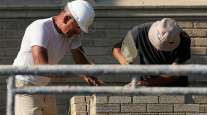Jobless Claims Hold Below 300,000 for Sixth Week

Fewer than 300,000 American workers filed applications for unemployment benefits for the sixth consecutive week, pointing to labor-market strength even as hiring cooled last month.
While a Labor Department report April 16 showed jobless claims increased by 12,000 to 294,000 in the week ended April 11, readings this low typically are consistent with an improving job market. The median forecast of 50 economists surveyed by Bloomberg News called for 280,000. The total number of people receiving benefits was the lowest since 2000.
Firings have remained low even as other labor-market data have shown the economy battled harsher weather, weaker demand from abroad and West Coast port disruptions early this year. A muted pace of dismissals, and job openings at a 14-year high, will help buoy hiring after payroll gains cooled last month.
“If you have a job, you’re probably not overly worried it’s going to go away,” Joshua Shapiro, chief U.S. economist at Maria Fiorini Ramirez Inc. in New York, said before the report. “They’re sending a different message than some other labor-market indicators pointing toward softness.”
Another report showed housing starts climbed less than forecast in March, indicating builders were slow to take advantage of more favorable weather and underscoring that the housing recovery remains temperate.
Work began on 926,000 homes at an annualized rate, up 2% from a 908,000 pace in February that was higher than previously estimated, according to figures from the Commerce Department. The median forecast of economists surveyed by Bloomberg News was for a 1.04 million rate. Building permits, a gauge of future construction, decreased.
Estimates in the Bloomberg survey for jobless claims ranged from 260,000 to 300,000. The Labor Department revised the prior week’s reading to 282,000 from an initially reported 281,000.
No states were estimated last week, and there was nothing unusual in the data, a Labor Department spokesman said as the report was released.
The four-week average of claims, a less-volatile measure than the weekly figure, was little changed at 282,750 compared with an almost 15-year low of 282,500 in the prior week.
The number of people continuing to receive jobless benefits dropped by 40,000 to 2.27 million in the week ended April 4, the fewest since December 2000. The unemployment rate among people eligible for benefits held at 1.7%. These data are reported with a one-week lag.
While job listings have jumped, reaching a 14-year high of 5.1 million in February, hiring has shown signs of slowing from its steady gains over the past year.
Employers added 126,000 workers in March for the lowest reading since December 2013. The gain was weaker than the most pessimistic forecast in the Bloomberg survey of 98 economists and ended a 12-month streak of increases of 200,000 or more.
Small-business managers also tamped down hiring plans in March, data from the National Federation of Independent Business showed April 14. A net 10% share of respondents said they planned to add to staffs in the coming months, the third straight decline and the fewest since October, according to the report.
Companies such as San Francisco-based Wells Fargo & Co. remain optimistic about the economic outlook as more Americans are employed.
“While the first-quarter economic headlines, again, demonstrated that the economic recovery has been uneven, I believe the underlying economic expansion that is approaching its sixth anniversary remains largely on track,” CEO John Stumpf said on an April 14 earnings call, citing job gains, low interest rates and consumer confidence among reasons the housing market will heal further this year.
Severe weather probably was at least partly to blame for the disappointing March payrolls reading, signaling staffing might be posed to rebound as temperatures warm. Other data this week showed that the economy may need more time to recover as slower global growth and further supply disruptions from the West Coast port workers’ labor dispute earlier this year also have weighed on demand.
Consumers have been slow to boost spending after harsh winter weather chilled shopping, according to retail sales data released April 14. Consumer purchases increased 0.9% in March, the first gain in four months. The median forecast of 87 economists surveyed by Bloomberg projected retail sales would advance 1.1%.




